| Adalbertus |
| Polish Infantry Figures, 1939, and Polish Roadside Shrine |
|
Kit Numbers: 35001 Polish Infantryman 1939 35002 Polish NCO 1939 35003 Polish Infantryman with M35 'UR' Anti-Tank Rifle 1939 35501 Polish Roadside Shrine |
| Reviewed by Mike Dobrzelecki |
| Images in this review were provided the reviewer by Adalbertus. |
|
MSRP: Euro 10.00 for figures, Euro 7.00 for Roadside Shrine Price Available Directly From Adalbertus' website www.adalbertus.com.pl/. Contents and Media: Resin - See Text for Details Advantages: Nicely sculpted and cast resin figures, comprehensive history, assembly and painting instructions. Disadvantages: None Recommendation: Highly Recommended INTRODUCTION Among the many myths about the Polish Armed Forces perpetuated by news people and historians alike in the west was that the Poles were equipped with an antiquated army in all respects. Any quick and fair assessment of the facts, reveal that this is far from the truth. In fact, in 1939 the Polish Army was larger and, either as good or better equipped than their U.S. counterpart, in terms of equipment, arms and, shockingly, armor. Considering the meager budgets they had to work with, Poland fielded a combined-arms force that was pretty formidable. Their performance in the September Campaign in 1939 bears this out. Poland's defeat by German arms was cast in stone long before either army mobilized. Poland was effectively surrounded by Germany on three sides by early 1939, months before World War II started. There was the long border with Germany on Poland's west side, Germany's territory in East Prussia to Poland's north and the new Czecho-Slovakian lands to Poland's south, from which Germany first chopped off the Sudentenland in the fall of 1938 and then occupied in whole by March 1939 in bloodless takeover. To the east lay the Soviet Union - no help could be expected there, as Stalin had been itching for pay-back ever since the Poles defeated them handily in the Polish-Soviet War of 1920 and "Uncle Joe" put his own plan into effect to seize Poland's eastern section as agreed to in the secret protocols of his Non-Aggression Treaty signed with "Dear Adolf" in August 1939. Poland's strategic diplomatic plan, skillfully crafted in 1939, relied on their allies - Great Britain and, especially, France, to come to Poland's aid, while the Poles held off the German invasion. The Polish Army's military plan relied on a 'forward defense', holding the Germans at arm's length, if you will, from the capitol, Warsaw, while their allies commenced their own offensives from Germany's western side. In the end the Polish plan was faulty on both counts. True, both England and France declared war on Hitler's Germany, but their armies sat in idleness behind their own defenses launching not one serious operation against the Germans. "The rest", as they say, "is history." It is the details of this history, however, that captivate the avid history buff and historian alike. Steve Zaloga, in his excellent capsule Osprey Campaign series book, "Poland 1939 - The Birth of the Blitzkreig", reports that The Germans casualties included 16,000 dead, 32,000 wounded, 674 tanks knocked out, of which 217 were total write-offs, 319 armored cars, 195 artillery pieces, 6,046 vehicles and 5,538 motorcycles. Jerzy Cynk stated that the Luftwaffe lost 258 aircraft destroyed and a further 263 damaged, of which from the latter category, counting those classified as beyond repair, pushes the actual combined destroyed and written-off total to between 330 and 340 aircraft. Without doubt, on either a pound for pound basis, or an accounting adjusted for size, the Poles did infinitely better than the French in the spring of 1940 against the German Blitzkreig. Modelers who like Polish subjects are in their glory these days when it comes to aircraft, vehicles and, even ship models. When it comes to figures, however, after Napoleonics, the range of choices for Polish themed figures diminishes exponentially, especially circa September 1939. Until recently, with the companies that did offer Polish figures, many of the renderings left a lot to be desired, either knocking off the worst early issue Tamiya figures as shallow conversions, or rendering a human form with a torso and face so stretched that although similar examples might exist in real life, they more resemble some of the alien characters seen in the classic 1960's American sci-fi TV series, "Outer Limits". This is slowly turning around with better crew figures recently being offered, both in 1/48th scale to go with the Mirage Polish aircraft kits and 1/35th scale to go with the Mirage Hobby armor kits. Wojciech Bulhak, formerly with Mirage Hobby, has joined the fight with the establishment of his cottage industry company, "Adalbertus", which has just debuted his new line of figures and accessories. The Adalbertus line will not be limited to either Polish figures, or scale, with 120mm and 1/48th scale figures either already available or in the offing. This review covers four of his initial offerings. 35001 Polish Infantryman 1939  Shown in a hunched over (he's taking advantage of cover, obviously) running pose, this figure (let's call him Stasiu, or Stash, for short) is wearing the standard uniform for the Polish front line army units, the wz.36 (Model Year 1936) woolen uniform, consisting of a shirt and pants.
Some sources describe this as an olive-green khaki color (Zaloga in at least one old article I have), although most examples that I have seen tend more towards a brownish-tan khaki.
In fact the links provided by Adalbertus' website (provided with this review) lead the viewer to a layout of the uniform and gear which confirm the brownish tan tinge to the woolen uniform.
There was also a summer uniform made from linen, which tended to fade faster than the standard wz.36 with wear and repeated washings.
Shown in a hunched over (he's taking advantage of cover, obviously) running pose, this figure (let's call him Stasiu, or Stash, for short) is wearing the standard uniform for the Polish front line army units, the wz.36 (Model Year 1936) woolen uniform, consisting of a shirt and pants.
Some sources describe this as an olive-green khaki color (Zaloga in at least one old article I have), although most examples that I have seen tend more towards a brownish-tan khaki.
In fact the links provided by Adalbertus' website (provided with this review) lead the viewer to a layout of the uniform and gear which confirm the brownish tan tinge to the woolen uniform.
There was also a summer uniform made from linen, which tended to fade faster than the standard wz.36 with wear and repeated washings.
The wz.36 greatly resembled German feld grau uniform in cut and fit, if not in color, which is why figure modelers often converted later war German figures into Polish ones. Second line and reserve units in the Polish army soldiered on with their older French style wz.28 uniforms, complete with puttees and Hadrian helmets. The front line units had the more modern wz.31 steel helmet, which was dipped in shredded cork to deaden its luster and break up its smooth domed outline. The wz.31 resembled the later U.S.WWII helmets, although the Poles version was somewhat deeper. Stash is armed with a wz.98 license-built Polish Mauser 98k, the same rifle the German's used throughout the war. The rest of the equipment includes the following: - wz.35 Rucksack - wz.33 Bread Bag - Rolled Blanket (what, no wz. Number!?) - wz.32 Gasmask - Spade (again no wz.number, but it closely resembles its German counterpart) - wz.29 Bayonet - Shoes with ankle wraps - Ammo pouches - Mess tin Cast in a nice light gray resin, the figure is provided in more separate parts than the usual figure you get in either plastic model kits, or as single figures. This method allows more detail to be imparted to the figure and the gear and it really paid off with the Adalbertus offerings - my congratulations to the sculptor, Marcin Kazmierczak. Stash's body is broken down into the upper torso, complete with collar, pockets and webbing, the lower trunk with half the legs, the two lower legs, the shoes and, of course, a full head. Each equipment item mentioned above is a separate casting. The folds in the uniform are well done and there are virtually no mold lines to remove. The webbing is well defined and seemingly even have a bit of undercut so favored my figure modelers. Stash's head is well sculpted - you'd recognize him, if you saw him again. The helmet is hollow and its sidewalls are thin and to scale, which would allow it to be shown off the figure, although you would have to add webbing to it. Unlike some resin figures, all of the fine equipment castings are nicely formed with no bent or misshapen parts, including the smallest items, such as the Polish Mauser, the spade and the bayonet. The figure modeler will have to remove the usual pour stubs and gates and, even if you ruin one of the small items, most can be easily replaced with counterparts from injected German figure and armor kits. The Adalbertus kits provide instructions, which are better than most. Combined with the two-photo box cover art, the modeler should be able to knock out an accurate figure right out of the box. The kit's instructions include detailed painting instructions for each item on the uniform and the gear. Paint references to both Humbrol and Vallejo Model Colors are included for each item. There is a front and back 3/4 view line drawing of a standing-at-ease generic Polish infantryman on the small sheet, along with drawings of the spade and bayonet, as well as rank badges. The instructions include a color key for the rank badges. The instructions include some important text on the precise placement of the equipment, as well as some construction tips, which I would encourage even the experienced figure modeler to read, because no one is an expert. I would refer both the average non-Polish speaking modeler and Polish linguists to Steve Zaloga's Osprey "Men at Arms" book, "The Polish Army 1939-1945" for more details and background, a reference that Adalbertus includes on their website, so it must be pretty good. Their website lists other references, which was helpful to me since all I have to do is find that specific magazine in my collection. For non-Polish modeling experts, the instructions also include a note on what "wz." means for Polish gear. Simply stated, "wz." is an abbreviation of "Wzor" - English translation = model or mark number. Of course, the Polish word has a slanted mark over the "o", which denotes a specific pronunciation, but my PC is not equipped with Polish language Word software. 35002 Polish NCO 1939  The NCO figure, sculpted this time by Rafal Zelazo, is posed as a prone figure lifting his head and torso up slightly and pointing at some important event in the distance, probably uttering some command, if his face's expression is any indication.
The lower legs are integral with lower truck and upper legs.
The NCO figure, sculpted this time by Rafal Zelazo, is posed as a prone figure lifting his head and torso up slightly and pointing at some important event in the distance, probably uttering some command, if his face's expression is any indication.
The lower legs are integral with lower truck and upper legs.
Otherwise, the breakdown of the figure is pretty much like the Infantryman. The same holds true for the instruction sheet, which includes the same front and back 3/4 view line drawing and painting details. This kit's sheet includes a sentence regarding how the NCO's fit into the command structure. Adalbertus includes 4 views of this figure on the box art. 35003 Polish Infantryman with M35 "UR" Anti-Tank Rifle 1939  Figure with Big Gun - now we're talking!
The Kb ppnac wz.35, or M35 "UR" 7.92mm Anti-tank rifle was one honking big bolt-action rifle.
Kept secret by the Poles, it was issued to Polish units just before the war broke out.
Their packing crates were marked, "Do not open: surveillance equipment".
That's also apparently where the "UR" designation comes from, since Polish surveillance equipment was exported to, of all places, Uruguay.
Its full name in Polish is Karabin Przeciwpancerny wz.35 and, as I can practically feel thousands of English speaking brains seizing up around the globe as they read this line, chock full of too many seemingly unrelated consonants in a row, it's just, "Antitank Rifle, Model 1935, in Anglo.
It is thought that as many as 6,500 UR's were produced prior to the outbreak of the war.
Figure with Big Gun - now we're talking!
The Kb ppnac wz.35, or M35 "UR" 7.92mm Anti-tank rifle was one honking big bolt-action rifle.
Kept secret by the Poles, it was issued to Polish units just before the war broke out.
Their packing crates were marked, "Do not open: surveillance equipment".
That's also apparently where the "UR" designation comes from, since Polish surveillance equipment was exported to, of all places, Uruguay.
Its full name in Polish is Karabin Przeciwpancerny wz.35 and, as I can practically feel thousands of English speaking brains seizing up around the globe as they read this line, chock full of too many seemingly unrelated consonants in a row, it's just, "Antitank Rifle, Model 1935, in Anglo.
It is thought that as many as 6,500 UR's were produced prior to the outbreak of the war.
Before you laugh at the 7.92mm caliber, imagine a standard Mauser 7.92 round made from lead with a steel coating (okay, nothing special - just like ordinary infantry bullets) fired with the equivalent of a 20mm or higher cartridge - the cartridge length was 131.2mm and overall weight was 64.25 grams. With a muzzle velocity of 1275 meters per second, this DS round could penetrate 30mm vertical thick armor at 100m, most any German armored vehicle up to a Panzer Mk.IV, and there were not many of these larger German tanks around in the September Campaign. It could penetrate 15mm of sloped armor. The instruction sheet restates the German's armor losses a bit differently than in Zaloga's book, in that it notes that the Germans lost 993 armored vehicles of all types, mostly to the Bofors 37mm anti-tank guns and the UR rifle, although some of the Polish French 75's and other artillery pieces probably accounted for more than a few. Fed from a 4 round box magazine, the rifle was 1760mm long with the barrel accounting for 1200mm of that span. It weighed 10kg (about 22.05 pounds) and had a rate of fire of about 8-10 rounds per minute. It had a folding bipod mounted the front, which is pretty much a required design feature to fire this AT rifle. A large number of these AT rifles were captured by the Germans, and they saw service with the Afrika Korps, renaming it the Panzerbuschse 35 (polnisch), or PzB 35 (p), for short. The Italians got a few, too, calling it the fucile controcarro 35 (P), which sounds like a pasta dish to me, but probably made sense to the Italians. A few of these weapons supposedly were used by the AK, The Polish Home Army, during the Warsaw Uprising in 1944. I had the opportunity to handle a surviving real Kb ppnac wz.35 "UR" and a DS round in the summer of 1989, when the MWP (Muzeum Wojska Polskiego, or Polish Army Museum) lent a collection of Polish uniforms, weapons, insignia and other artifacts to the Intrepid Sea-Air-Space Museum for their exhibit, "Poland Invaded", on which I served as a Project Supervisor. This is one heavy weapon to have to lug around, which is probably why a fire team of 1-3 guys was assigned to properly use the weapon in combat. Courtesy of Sev Mendez, the Intrepid's uniform curator, I also got to examine a lot of other Polish gear. In fact, I saw everything you get with the Adalbertus kits mentioned in this review, and a couple not mentioned, including the rkm wz.28, the Polish knock-off of the famed Browning B.A.R. light machine gun, and an original Enigma machine. Oh yeah, the figure - The 'UR' gunner figure is broken down similarly to the Polish Infantry figure 35001 and is posed firing the AT rifle from the classic prone position. The box art has 3 photos of the completed figure and the instruction sheet includes the information mentioned in my review of the other two kits and background information on the M35 "UR' AT Rifle and includes references to a couple of websites, which I liberally mined for the description of the rifle in this review. The AT rifle comes in three parts - stock with main body, bipod and barrel, and is packaged separate from the figure parts along with all the other equipment. My compliments to Rafal Zelazo who sculpted this figure. 35501 Polish Roadside Shrine  Poland's existence and current freedom squarely rests on its strength of the faith of its people and adherence to the Catholic religion.
It is therefore entirely appropriate that Adalbertus has elected to offer a Polish roadside shrine in resin with a figure of The Virgin Mary, the Mother of Jesus Christ.
Poland's existence and current freedom squarely rests on its strength of the faith of its people and adherence to the Catholic religion.
It is therefore entirely appropriate that Adalbertus has elected to offer a Polish roadside shrine in resin with a figure of The Virgin Mary, the Mother of Jesus Christ.
Consisting of three simple parts, the stucco/cement shrine with an alcove for a religious statue, a cross for the top and a small statue of the Blessed Virgin Mary, the kit is well molded. The instruction sheet includes painting suggestions with variations for finishing the statue, either from wood or gypsum, painted or unpainted. For the non-Christian and non-Catholic the proper colors for the Blessed Virgin Mary statue are called out on the sheet. Alternately, the kit provides both black and white, as well as color photo images, of two regional types of Polish Madonnas, The Holy Virgin of Ostra Brama in northeastern Poland or the classic, Our Lady of Czestochowa, common to central and eastern Poland. The color images are to be cut from the box art cover sheet. The black and white versions are on the instruction sheets. This type of religious shrine, ubiquitous in the Polish countryside, would be appropriate for any diorama set in Poland in the 20th century and I have a number of diorama ideas in mind for this kit. The multiple images of Mary could also be useful for other applications. I would venture a guess to say that Wojciech knocked a couple of millennia off his stay in purgatory with the issue of this fourth kit. This is a good start for Adalbertus and I eagerly await future kits. Another that is already available is a US OIF Sniper, Iraq, 2005 figure in 120mm scale. |
|
Information, images, and all other items placed electronically on this site are the intellectual property of IPMS/USA ®. |